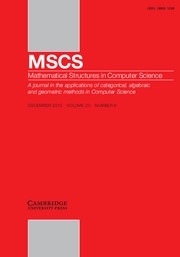Crossref Citations
This article has been cited by the following publications. This list is generated based on data provided by
Crossref.
König, Barbara
2007.
Algebra and Coalgebra in Computer Science.
Vol. 4624,
Issue. ,
p.
36.
Di Gianantonio, Pietro
Honsell, Furio
and
Lenisa, Marina
2008.
Foundations of Software Science and Computational Structures.
Vol. 4962,
Issue. ,
p.
334.
Gadducci, Fabio
and
Monreale, Giacoma Valentina
2008.
Graph Transformations.
Vol. 5214,
Issue. ,
p.
115.
Rangel, Guilherme
König, Barbara
and
Ehrig, Hartmut
2008.
Foundations of Software Science and Computational Structures.
Vol. 4962,
Issue. ,
p.
413.
Murakami, Masaki
2008.
Theoretical Aspects of Computing - ICTAC 2008.
Vol. 5160,
Issue. ,
p.
243.
Bonchi, Filippo
Gadducci, Fabio
and
Heindel, Tobias
2008.
Graph Transformations.
Vol. 5214,
Issue. ,
p.
226.
Birkedal, Lars
Debois, Søren
and
Hildebrandt, Thomas
2008.
CONCUR 2008 - Concurrency Theory.
Vol. 5201,
Issue. ,
p.
218.
Rangel, Guilherme
Lambers, Leen
König, Barbara
Ehrig, Hartmut
and
Baldan, Paolo
2008.
Graph Transformations.
Vol. 5214,
Issue. ,
p.
242.
Brandt, Christoph
Hermann, Frank
and
Engel, Thomas
2009.
Enterprise, Business-Process and Information Systems Modeling.
Vol. 29,
Issue. ,
p.
339.
Bisztray, Dénes
Heckel, Reiko
and
Ehrig, Hartmut
2009.
Architecting Dependable Systems VI.
Vol. 5835,
Issue. ,
p.
308.
Bonchi, Filippo
Gadducci, Fabio
and
Monreale, Giacoma Valentina
2009.
Labelled Transitions for Mobile Ambients (As Synthesized via a Graphical Encoding).
Electronic Notes in Theoretical Computer Science,
Vol. 242,
Issue. 1,
p.
73.
Bracciali, Andrea
Bruni, Roberto
and
Lluch Lafuente, Alberto
2009.
On Symbolic Semantics for Name-decorated Contexts.
Electronic Notes in Theoretical Computer Science,
Vol. 229,
Issue. 3,
p.
37.
Di Gianantonio, Pietro
Honsell, Furio
and
Lenisa, Marina
2009.
RPO, Second-order Contexts, and Lambda-calculus.
Logical Methods in Computer Science,
Vol. Volume 5, Issue 3,
Issue. ,
Bonchi, Filippo
Gadducci, Fabio
and
Monreale, Giacoma Valentina
2009.
Foundations of Software Science and Computational Structures.
Vol. 5504,
Issue. ,
p.
272.
Bonchi, Filippo
Gadducci, Fabio
and
König, Barbara
2009.
Synthesising CCS bisimulation using graph rewriting.
Information and Computation,
Vol. 207,
Issue. 1,
p.
14.
Heindel, Tobias
2009.
Towards Secrecy for Rewriting in Weakly Adhesive Categories.
Electronic Notes in Theoretical Computer Science,
Vol. 229,
Issue. 3,
p.
97.
Hülsbusch, Mathias
2010.
Graph Transformations.
Vol. 6372,
Issue. ,
p.
391.
Goldsmith, Michael
and
Creese, Sadie
2010.
Refinement-Friendly Bigraphs and Spygraphs.
p.
203.
Bonchi, Filippo
Gadducci, Fabio
Monreale, Giacoma Valentina
and
Montanari, Ugo
2010.
Graph Transformations.
Vol. 6372,
Issue. ,
p.
123.
Bonchi, Filippo
Gadducci, Fabio
and
Monreale, Giacoma Valentina
2010.
On Barbs and Labels in Reactive Systems.
Electronic Proceedings in Theoretical Computer Science,
Vol. 18,
Issue. ,
p.
46.


